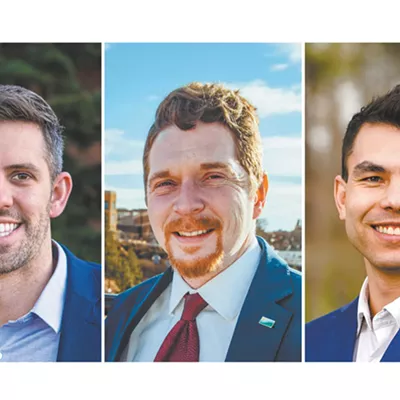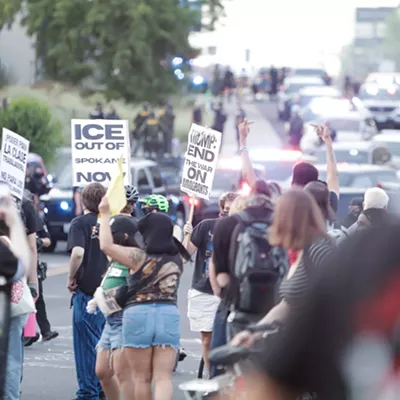In the metaphorical language of the seasons, the passing of fall into winter is often a time of sharpened awareness. We notice nightfall coming on early, the air is sharp with cold and the scent of dead leaves, and we sense the mysteries of life and death. November often begins with a festival for the dead -- a Dia de los Muertos or an All Souls Day, depending on your culture -- and more or less reflects the properties of Scorpio, the Black Widow sign of the zodiac. November is a time of reckoning, of looking back over the year and taking stock. And perhaps nowhere is the essence of November more strong than this November, the November of 2001. As the events of Sept. 11 begin to show up in the arts, reflected and transmuted into paintings, poetry or prose, many have commented on how such terrible events might actually be a necessary wake-up call. People continue to re-examine their lives as never before, and many artists, for instance cartoonist/writer Lynda Barry, writer Terry Tempest Williams and even the literary astrologer Eric Francis have suggested that underneath all the uncertainty, now might be a good time to look deeper at ourselves, our culture and everything we stand for.
The stark black-and-white drawings of Cuban-American artist JOSE BEDIA evoke the unfathomable nature of these times, and yet they were all completed earlier in the year, many finding their origin in the Angolan war of the mid-'80s. Bedia visited the Inland Northwest last November as the first speaker in the 2000-2001 Visiting Artist Lecture Series, a joint production of EWU, the Northwest Museum of Arts and Culture and SFCC, and it was during this visit that SFCC Gallery Director Tom O'Day approached Bedia about installing a show of his work, entitled "Back in Africa."
Born and raised in Cuba, Bedia was heavily influenced by the symbolism, language and spirituality of the Caribbean, which had originated in the African Diaspora and came west with the slave trade. In 1983 he was initiated into the Kongo Palo Monte religion, an African faith typified by strongly animistic practices; ritual work with spirits of nature, the dead and the elements; and ceremonies incorporating a nganga or cauldron. Bedia became a priest of Palo Monte, drawing upon both the mysterious rituals of his faith and also his travels in his uncompromising, inscrutable work. Bedia first visited Africa as a Cuban soldier during the Angolan war. He has since returned, most recently in 2000, and has also studied the artistic and religious traditions in Europe and Mexico, and also Native American traditions in the United States. A current resident of Miami, Bedia's recent visit to Africa resulted in the works for the show at SFCC.
The pieces are quietly disturbing but beautiful in their expressive furrows of black charcoal acrylic and muddied negative space. Nso Kiyumba appears to be the most autobiographical, with a helmeted figure staring out in bleak shadow, above him a bowl of bones, a nganga. In Mpangui, the figures take on the organic forms of people, weeds and roots. In Nsombo, an elongated shape suggests the hieroglyphic animals of Ancient Egypt -- a lion? a rabbit? -- which repeats and mirrors itself in larger waves of line. There is both rage and surrender in the work, both natural and unnatural beauty. It is art that effectively mirrors the unspoken anxieties we all pack around.
The exhibit comes to the SFCC via the Fredric Snitzer Gallery in Miami, which represents Bedia's work. Don't miss this rare chance to see an exhibit by this intriguing contemporary artist.
Jose Bedia's "Back in Africa" shows at the
SFCC Art Gallery through Nov. 30.
Closing Reception: Thursday, Nov. 29th from
5:30-7:30 pm. Call: 533-3710.
The Unforgettable Fire
The Spokane Arts Commission offers two shows this month: a PHOTOGRAPHY SHOW at the Chase Gallery in City Hall and the "AMERICAN WORKS" SHOW at the erstwhile Music City Building on First Ave. The American Works show stems directly from the September terrorist attacks and gathers varied levels of experience, from SFCC painting students to accomplished regional favorites like Harold Balazs, Dan McCann and Kay O' Rourke.
"I think this exhibit shows how important this issue really is, how it penetrated our consciousness as a whole, how we're not as confident as we once were," says Karen Mobley, director of the Spokane Arts Commission. "We put out an open call, and we had a great response, both from established artists and also from the general public, which I think adds a very interesting element to this show. Some of the works aren't as professional maybe, but there's really some heartfelt stuff. Some of it is really gut-wrenching."
Harold Balazs' shiny steel abstract sculpture has the helmet of a conquistador and two gleaming tower shapes. The construction reminds us of our own checkered colonial past while pointing to a new reality -- that we are, underneath it all, very much alike.
Dan McCann's box piece has by far the longest title in the show: God Encouraging the United States of America To Take a Second Look at Itself in a Universal Mirror, With Spirit Dove. The simple composition has a whirling night sky, and two figures, one, a denim pantsuited doll meant to represent God, and a smaller clown-faced figure, meant to represent humanity. They are standing together and looking into a mirror.
While some of the pieces, for instance Tony Curcio's canvas of muscular angels rescuing firefighters, express grief, others are more ironic. Charlie Schmidt's contribution to the show is simply a large white canvas, upon which are stenciled the words "Cheer Up, America." The starkness of the canvas and the inadequate presence of the lettering evokes the sense of "how do we cheer up?" while nevertheless eliciting laughter from the viewer.
The show opens in conjunction with the relaunch of the spokanearts.org Web site, which was originally scheduled in mid-September.
"I'm really confident that working in the arts, whether it's your job or your calling, is more important now than it's ever been," says Mobley. "The arts are psychologically, spiritually, intellectually uplifting as well as being an outlet for expression."
Over at the Chase Gallery, the photography show is not linked to Sept. 11, but instead brings together five Spokane photographers, Charles Gurche, Rick Singer, George Chambers, Del Lusk and Hermon Joyner.
"These are all artists who kind of work out of that modernist tradition, who have a sort of Ansel Adams approach to their work," says Mobley. "There's an emphasis on nature, and then their work often diverges off of that."
While I appreciated all of the works in the show, I was most drawn to the eerie and atmospheric pieces by Del Lusk. Photographed mainly in Sardinia, Lusk's work captures strangely crooked trees and large standing stones, many the size of a man and peched upright on hillsides. There is the sense with many of these that you're walking into an ancient graveyard or long-abandoned sacred space. Interior, Stronghold at Nuraghi: Palmavera, Sardinia was especially interesting in this vein, with its strong contrasts and feeling of being in complete darkness, except for a shaft of light and a sort of altar stone.
"American Works" opens at the Music City Building, 1011 W. First Ave., on November 15. The photography show at the Chase Gallery in City Hall, 808 W. Spokane Falls Blvd., is open and runs through Dec. 28. Call: 625-6050.














